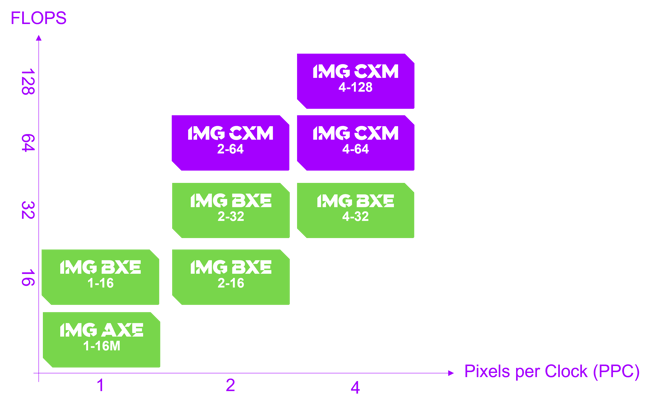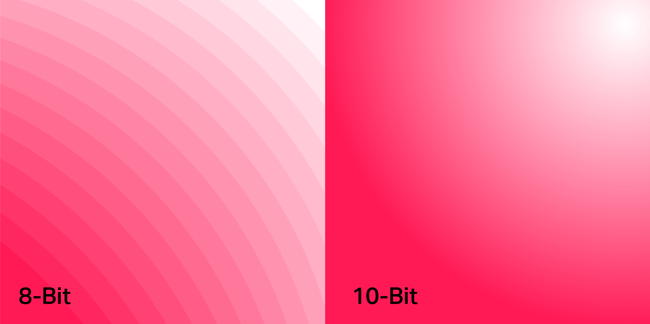- 23 May 2023
- Eleanor Brash
This week we launched a new GPU, IMG CXM. Its three configurations scale to offer seamless user interfaces for consumer devices as diverse as wearables and premium digital televisions.
What do consumer devices need from a GPU?
The wearable market, covering smartwatches and smart glasses, provide easy-to-access information to consumers on the move. While the screen sizes are small, for good reviews the interface must respond instantly to the touch of a fingertip or the sound of a voice. In the case of smart glasses, this could involve a level of edge AI, which when you consider that the SoC and battery must fit comfortably on a wrist, is challenging. And on top of all this, wearables have to keep going for the entire day. Battery management is critical.
The Smart Speaker market is evolving. Many devices currently shipping are more like a tablet with a high quality speaker and AI functions such as voice recognition built-in. In the home, they are replacing the calendar on the fridge and the cookbook on the counter. They are the device used for video calls, with an autofocusing camera enabling users to stay on the go while touching base with family and friends. The GPU needs to offer great graphics as well as 1-10 TOPS compute performance to support AI functions.
Keen to hold onto the attentions (and subscription fees) of consumers, content providers such as Netflix and Disney+ are upgrading their TV applications. Their latest are rich in HDR colour, gone are the days of jagged edges to text, and the navigation through the app is responsive (60FPS+) and intuitive. GPUs for this market need to be feature-rich and able to handle the rendering requirements of large screens – but not drag the cost for the total SoC above the sweet spot of $20.
For all these use cases area efficiency, power efficiency and a graphical user interface focused design are GPU must-haves. The performance density of IMG CXM– boosted 50% over that of previous generation BXM cores – along with a feature set tailored to the demands graphical user interfaces (GUIs) make this GPU range a perfect fit.
The three IMG CXM configurations available are:
- CXM-2-64: the smallest GPU to support full native HDR applications; performance of 2ppc and 64 FLOPS
- CXM-4-64: an efficient core running at 4ppc and 64 FLOPS
- CXM-4-128: a performance dense option for premium consumer devices; performance of 4ppc and 128 FLOPS

HDR Graphical User Interfaces
HDR (high dynamic range / HDR10) capable devices can render content with much better contrast between light and dark areas. HDR content has access to 1 billion colours per pixel (rather than the 16 million of SDR), leading to more accurate colour matching and a much closer representation on-screen of what the eye perceives in real life.
Content providers are not just streaming HDR videos to those with an HDR-ready device, their applications are also adopting 4K and HDR within the GUI to deliver a seamless visual experience. From the moment a user first opens a streaming app to the moment the credits roll at the end of an episode, there shouldn’t be a sudden step change in the quality of graphics displayed.
IMG CXM is the only GPU in Imagination’s range to offer native support for HDR content; more precisely IMG CXM offers both RGBA10-10-10-10 and YUV10 surface/texture support for digital TV HDR graphical user interfaces. The impact of HDR can be seen clearly in the image below where the higher bitrate image has less visible banding.
 8-bit RGBA (SDR) versus 10-bit RGBA (HDR)
8-bit RGBA (SDR) versus 10-bit RGBA (HDR)
Tiny Frame Buffer Compression
IMG CXM is also the only GPU to feature the second generation of Imagination’s Tiny Frame Buffer Compression solution – TFBCv2.
Frame buffer compression and decompression is essential for area and power management. By compressing image data when it is written to or read from memory, overall GPU bandwidth consumption can be lowered. Imagination GPUs are based on a tile-based deferred rendering architecture. Our compression solution works on a tile-by-tile basis where each tile can achieve a different compression ratio independent of the tiles around it. This means that a more detailed area of an image could be compressed less than an area of lower detail.
Imagination also operates a lossy / lossless dual pipeline for compression. The system designer sets the compression target, and if a tile can achieve that target with a lossless algorithm it compresses the data with no visual changes. If not, the tile is compressed with the lossy algorithms. This provides a guaranteed compression rate which smooths bandwidth usage from the GPU and reduces the image buffer memory footprint – essential for low-area, low-cost consumer devices.
The first version of Tiny Frame Buffer Compression (TFBC) launched with the B-Series and offered three lossy compression ratios (75% - effectively perfect, 50% - visually lossless, 25% - high bandwidth saving) as well as a lossless mode. It delivers more quality modes in a smaller area than Imagination’s image compression solution for our high performance GPUs, PVRIC.
TFBCv2 brings a boost to visual quality for the 75%, 50% and 25% compression modes and prioritises a smooth frame rate. It also adds a new quality mode to bring system designers even more flexibility: 37.5% for moderate bandwidth saving.
The demo video below shows the differences in visual quality and memory bandwidth consumption between the different compression modes.
Ecosystem is Everything
Both the television and Smart Home markets have their own ecosystems in which Imagination actively participates and there is also significant overlap with the ecosystem of the mobile market where Imagination, one of the highest shipping GPU IP providers, has deep roots. Many wearable, DTV and Smart Home devices run on Android, for example. Imagination GPUs have been Android enabled devices for fifteen years. As Android has expanded out of the mobile space, Imagination has developed its DDK to enabled Android based experiences on any device. That includes RISC-V based devices, which Google confirmed as a Tier 1 architecture in December 2022. Imagination GPUs are an ideal accompaniment to a RISC-V project. Our teams have extensive knowledge of the technology thanks to our own Catapult line of CPUs, our GPUs have been optimised to work alongside RISC-V application processors and they are already shipping in RISC-V based SoCs on the market today.
The IMG CXM-2-64, CXM-4-64 and CXM-4-128 GPUs are available for licensing immediately. Please contact us for further information.






